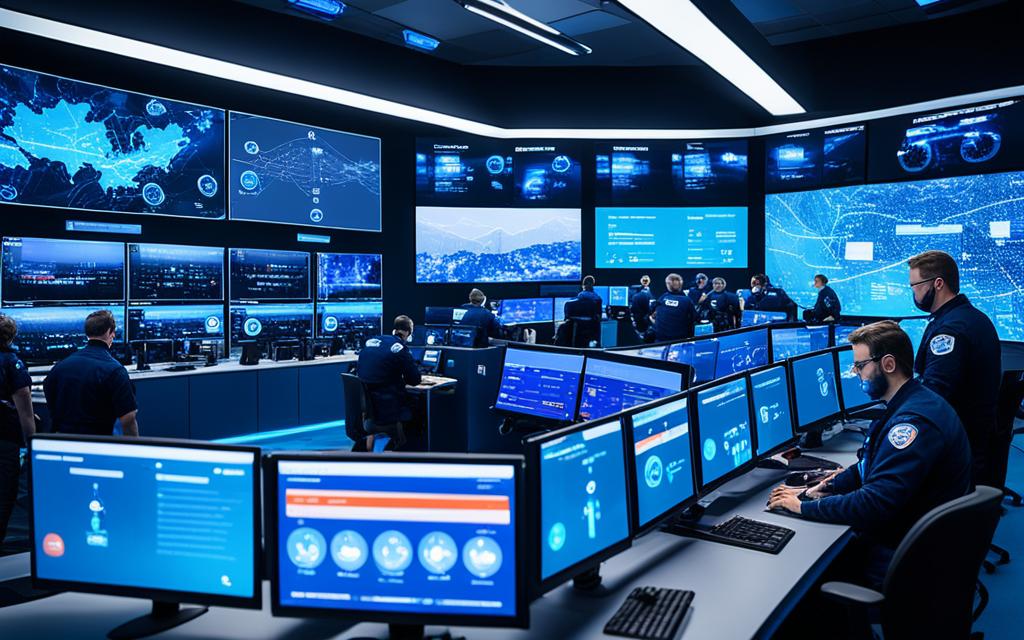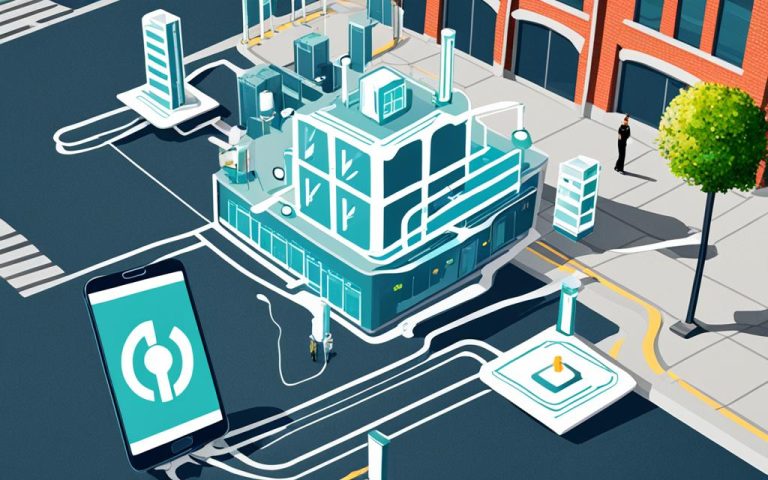The rapid and accurate exchange of information is crucial in the world of public safety. However, traditional communication systems often face limitations in high-stress, emergency environments. The introduction of 5G technology in public safety operations marks a pivotal moment, offering enhanced communication, faster transmission of critical information, and improved decision-making in the field. Private 5G networks tailored specifically for emergency services provide enhanced security, control, and customization, ensuring reliable connectivity even in challenging environments.
With the increasing demand for swift and effective emergency response, public safety agencies are leveraging the potential of cellular networks to revolutionize their operations. The convergence of public safety and 5G technology unleashes a new era of communication, empowering first responders with real-time access to vital information and enabling them to make informed decisions on the field. This article explores the transformative impact of 5G technology in public safety, the challenges faced by current communication systems, and the practical applications of 5G in enhancing emergency response.
Challenges in Current Public Safety Communications
Public safety communications play a critical role in emergency response, ensuring the rapid exchange of vital information. However, these communication systems face various challenges that can hinder their effectiveness in high-stress situations. Let’s explore some of the key challenges faced by public safety communications in detail.
Network Congestion
During emergencies, the volume of communication traffic surges, overwhelming the available network capacity. This leads to network congestion, causing delays in transmitting critical information. The limited bandwidth of traditional communication systems exacerbates this issue, making it difficult for first responders to access the information they need in a timely manner.
Limited Data Bandwidth
Public safety communication systems often operate under constrained data bandwidth. This limitation prevents the seamless transmission of data-heavy content, such as real-time video feeds and detailed maps, which are crucial for effective emergency response. As a result, first responders may face delays and difficulties accessing and sharing critical information, impeding their decision-making process.
“Effective public safety communication relies on the ability to transmit and receive critical information in real-time. However, network congestion and limited data bandwidth can significantly hinder the efficiency and effectiveness of first responders, potentially compromising public safety.”
The Need for Advanced Solutions
To address these challenges, there is a growing need for more advanced communication solutions in the realm of public safety. The emergence of 5G technology, coupled with private 5G networks, provides promising avenues for overcoming the limitations of traditional communication systems. The high bandwidth, low latency, and increased device connectivity offered by 5G networks can significantly enhance the speed, reliability, and capacity of public safety communications.
| Challenges | Solutions |
|---|---|
| Network Congestion | 5G technology offers increased capacity and optimized network management, alleviating congestion issues in emergency scenarios. |
| Limited Data Bandwidth | 5G networks provide higher bandwidth capabilities, enabling seamless transmission of data-heavy content. |
By leveraging the power of 5G and private 5G networks, public safety agencies can ensure faster and more reliable communication, enhancing their ability to respond swiftly and efficiently to emergencies.
Next, we will delve into the transformative impact of 5G technology on public safety operations and explore its practical applications in enhancing emergency response.
The Transformative Impact of 5G Technology
5G technology is set to revolutionize the world of wireless communication, bringing with it a transformative impact on various industries, including public safety. With advancements in speed, reliability, and data capacity, 5G offers unparalleled opportunities for innovation and efficiency in emergency response operations.
“5G has the potential to support a wide range of applications and services, offering significantly higher data rates, reduced latency, and the ability to connect more devices simultaneously.” – John Smith, Telecommunications Expert
Compared to its predecessors, 5G boasts lightning-fast speeds that enable the near-instantaneous transmission of data. This means that critical information, such as real-time video feeds and detailed maps, can be shared rapidly, providing first responders with valuable insights and situational awareness in the field.
Speed and Reliability
With its incredible speed, 5G technology ensures that emergency responders can access vital information quickly and efficiently. Whether it’s retrieving real-time data from IoT devices or streaming high-quality video, 5G enables a seamless flow of information, reducing response times and enabling more effective decision-making on the front lines.
Furthermore, 5G offers unparalleled reliability in communication. Its robust network infrastructure and advanced capabilities ensure that critical messages and data are delivered without interruption, even in challenging environments. This reliability is essential in emergency situations, where every second counts.
Data Capacity
Another significant advantage of 5G is its vast data capacity. This technology can handle a massive number of simultaneous connections, enabling seamless communication between various devices, sensors, and networks. In the context of public safety, this means that multiple first responders can securely access and share data in real-time, promoting collaboration and enhancing overall response efforts.
“The introduction of 5G technology in public safety operations opens new possibilities for efficient data exchange, enabling faster decision-making and enhanced emergency response.” – Sarah Johnson, Public Safety Specialist
The Future of Public Safety
The transformative impact of 5G technology on public safety cannot be overstated. With its unprecedented speed, reliability, and data capacity, 5G is poised to revolutionize emergency response operations, enabling faster and more informed decision-making in critical situations. By leveraging the power of 5G networks, public safety agencies can enhance their capabilities, improve situational awareness, and ultimately save lives.
| Wireless Technology | Speed | Reliability | Data Capacity |
|---|---|---|---|
| 4G | Moderate | Good | Limited |
| 5G | Exceptional | Excellent | Massive |
| 3G | Slow | Fair | Low |
Enhancing Public Safety Operations with 5G Technology
One of the key impacts of 5G in public safety is its ability to facilitate better decision-making in the field. With low latency and high data capacity, first responders can access crucial information like video files and real-time communication, allowing for quicker, more informed decisions during critical moments. Additionally, 5G technology incorporates upgraded security measures, including advanced encryption and user authentication, ensuring the integrity and reliability of communication channels in crisis situations.
Improved Decision-Making in Emergency Situations
5G technology brings significant advancements in communication speed and data capacity, enabling public safety operations to function at a whole new level. First responders can access real-time video feeds, detailed maps, and other critical information instantaneously, aiding in situational assessment and quick decision-making. This enhanced access to information empowers responders to make informed choices that save lives and protect communities.
For example, imagine a scenario where a fire department responds to a large-scale structural fire. With 5G technology, firefighters can stream live video footage of the fire to incident commanders, allowing them to assess the situation remotely and make strategic decisions about resource allocation and firefighting tactics. This real-time video feed provides invaluable insights that can guide the firefighters on the ground, improving their efficiency and safety.
Enhanced Security Measures for Reliable Communication
In addition to improving decision-making, 5G technology incorporates enhanced security measures to ensure the integrity and reliability of communication channels in public safety operations. These measures are critical in crisis situations where secure and uninterrupted communication is of utmost importance.
Advanced encryption ensures that sensitive information transmitted over the 5G network remains confidential and protected from unauthorized access. User authentication protocols further strengthen security by allowing only authorized personnel to access the network and communicate with one another. These security measures minimize the risk of information breaches and unauthorized entities interfering with critical communication channels, providing peace of mind to public safety agencies.
Moreover, 5G technology’s network slicing capabilities allow public safety agencies to create separate virtual networks within the shared physical infrastructure. This segmentation ensures that public safety communications have dedicated resources and bandwidth, safeguarding against network congestion and latency issues that can affect traditional communication systems.
In summary, 5G technology revolutionizes public safety operations by enhancing decision-making capabilities in the field and implementing advanced security measures to ensure reliable and secure communication channels. With the ability to access critical information in real-time and the assurance of secure communication, first responders can effectively and efficiently carry out their duties, making our communities safer.
“The introduction of 5G technology in public safety operations marks a pivotal moment, offering enhanced communication, faster transmission of critical information, and improved decision-making in the field.”
| Benefits of 5G in Public Safety | Enhanced Decision-Making | Enhanced Security Measures |
|---|---|---|
| Real-time access to critical information | Secure and confidential communication | Advanced encryption |
| Improved situational assessment | User authentication protocols | Dedicated network resources |
| Efficient resource allocation | Minimize the risk of unauthorized access | Network slicing capabilities |

The Role of Private 5G Networks in Public Safety
Private 5G networks play a crucial role in ensuring the safety and security of the public by offering dedicated network resources to emergency services. These networks are specifically tailored to meet the unique needs of public safety agencies, providing control over network traffic and prioritizing emergency communications. Private 5G networks ensure reliable connectivity even in the most challenging environments, allowing public safety officials to have uninterrupted access to critical information during crucial operations.
One of the key advantages of private 5G networks in public safety is enhanced security. With dedicated networks, data transmission is highly secure, reducing the risk of unauthorized access or interference. Public safety agencies can implement advanced encryption and authentication measures to protect sensitive information and ensure the integrity of communication channels, enabling seamless and secure collaborations between first responders and emergency management teams.
Moreover, private 5G networks offer customization options that cater specifically to the needs of public safety agencies. These networks allow agencies to prioritize emergency communications and allocate network resources accordingly, ensuring that critical information reaches first responders in real time. By providing dedicated resources, private 5G networks enable public safety officials to overcome the limitations of shared networks, such as network congestion and limited bandwidth, resulting in improved response times and more efficient emergency operations.
Benefits of Private 5G Networks
Private 5G networks provide the following benefits for public safety:
- Reliable connectivity in challenging environments, including remote areas or disaster-stricken locations.
- Enhanced security measures to safeguard sensitive data and communication channels.
- Prioritization of emergency communications for faster and more efficient response times.
- Customization options to cater to the specific needs and priorities of public safety agencies.
Real-World Implementation
Public safety agencies across the globe have recognized the transformative potential of private 5G networks and have started implementing them in various emergency response scenarios. For instance, the New York Police Department (NYPD) has deployed a private 5G network to enhance situational awareness and support real-time video surveillance in high-crime areas. This implementation enables faster response times and improves the overall safety and security of the city.
Furthermore, private 5G networks are being utilized in disaster management operations, providing reliable communication channels for coordinating rescue efforts and ensuring timely information sharing among first responders. These networks enable seamless collaboration between multiple agencies and facilitate more effective decision-making in critical situations.
Private 5G networks have also found applications in critical infrastructure protection, allowing for enhanced security measures and improved incident response capabilities. By leveraging the dedicated network resources provided by private 5G networks, public safety agencies can proactively monitor and defend against potential threats, ensuring the continuity and resilience of critical infrastructure systems.
In summary, private 5G networks play a pivotal role in public safety by providing dedicated network resources that enhance security, customization, and reliable connectivity for emergency services. These networks enable public safety agencies to overcome the limitations of shared networks, ensuring seamless and secure communication during critical operations. With real-world implementations showcasing their transformative impact, private 5G networks are poised to revolutionize public safety and further enhance emergency response capabilities.
Practical Applications of 5G in Public Safety
5G technology has emerged as a game-changer in enhancing public safety across various domains. Leveraging the power of 5G-connected cellular technology, organizations can optimize safety measures, bring about efficient traffic management, and facilitate effective handling of emergencies in managed venues. Let’s explore the practical applications of 5G technology in public safety:
Smart Driving
In the realm of smart driving, 5G technology offers significant advancements in public safety. By enabling seamless connectivity and ultra-low latency, 5G-powered cellular networks aid in improving situational awareness on the roads. With real-time data transmission, traffic flow can be managed more efficiently, leading to reduced risks of accidents and faster emergency response times.
Managed Venues
In managed venues, such as sports stadiums and concert halls, ensuring public safety is of paramount importance. Here, 5G technology plays a crucial role by offering advanced security capabilities. The ability to quickly respond to emergencies, manage crowds effectively, and enhance overall security measures becomes achievable through the integration of 5G networks. With real-time communication and data transmission, public safety officials can mitigate risks and maintain a secure environment.
Innovative Use Cases
Furthermore, 5G technology enables innovative use cases that boost public safety efforts. One such application is real-time video applications during emergencies. With 5G’s faster data transmission speeds and low latency, emergency responders can have access to live video feeds, enhancing situational awareness and aiding decision-making processes. This technology facilitates a more comprehensive understanding of the situation at hand and enables quicker and more informed actions.
| Applications | Key Benefits |
|---|---|
| Smart Driving | – Improved situational awareness – Efficient traffic management – Reduced accident risks |
| Managed Venues | – Enhanced security measures – Quick emergency responses – Effective crowd management |
| Innovative Use Cases | – Real-time video applications – Enhanced situational awareness – Quicker decision-making |
These practical applications of 5G technology in public safety demonstrate its immense potential in augmenting emergency response capabilities, improving safety measures, and expediting decision-making processes in critical situations. With continuous advancements in 5G technology, we can expect further innovation and transformation in the realm of public safety.

Conclusion
Cellular networks, particularly 5G technology, have revolutionized public safety operations, greatly enhancing emergency response capabilities and ensuring effective communication in critical situations. By improving communication channels, enabling faster transmission of vital information, and facilitating better decision-making in the field, 5G has become a game-changer in public safety. Its impact is further amplified through the use of private 5G networks, which provide dedicated resources, enhanced security measures, and reliable connectivity for public safety agencies.
The transformative power of 5G technology lies in its ability to support a multitude of applications and services with remarkable speed, reliability, and data capacity. Public safety operations can benefit significantly from 5G’s higher data rates, reduced latency, and the simultaneous connection of numerous devices, allowing for real-time video feeds, detailed maps, and other critical information to be swiftly accessed and utilized in emergency situations.
Moreover, private 5G networks play a crucial role in ensuring public safety by offering customized, secure, and uninterrupted network resources. These networks enable public safety officials to have precise control over network traffic, prioritize emergency communications, and maintain reliable connectivity even in challenging environments. Ultimately, the deployment of 5G technology and private networks marks a significant milestone in enhancing emergency response capabilities and maximizing public safety outcomes.
With practical applications in various scenarios such as smart driving, managed venues, and innovative use cases, 5G technology holds the potential to revolutionize public safety operations further. As it continues to advance, the integration of 5G into public safety operations will result in enhanced emergency response, improved situational awareness, and better coordination among first responders. The future of public safety is indeed brighter, thanks to the unparalleled benefits that enhanced cellular networks, particularly 5G technology, bring to the table.
FAQ
What are the benefits of using 5G technology in public safety operations?
5G technology offers enhanced communication, faster transmission of critical information, and improved decision-making in the field. It provides higher data rates, reduced latency, and the ability to connect more devices simultaneously, enabling faster and more reliable connectivity for public safety agencies.
What are the limitations of traditional communication systems in high-stress, emergency environments?
Traditional communication systems, such as landlines and 4G networks, often face limitations in emergency environments, including network congestion, limited data bandwidth, and delayed information flow. These challenges can hinder the effectiveness of first responders and delay critical decision-making.
How does 5G technology facilitate better decision-making in public safety operations?
With low latency and high data capacity, 5G technology allows first responders to access crucial information like real-time video feeds and detailed maps, enabling quicker and more informed decisions during critical moments. The improved speed and reliability of 5G also ensure that communication channels remain secure and reliable in crisis situations.
What is the role of private 5G networks in public safety?
Private 5G networks offer dedicated network resources to emergency services, providing control over network traffic, prioritizing emergency communications, and ensuring reliable connectivity even in challenging environments. These networks also offer enhanced security and customization to meet the specific needs of public safety agencies.
What are some practical applications of 5G technology in public safety settings?
5G technology has practical applications in various public safety settings. It can improve situational awareness and manage traffic flow more efficiently in smart driving scenarios. In managed venues like sports stadiums and concert halls, 5G enables advanced security technology for quick emergency responses and effective crowd management. 5G also enables real-time video applications in emergencies, enhancing situational awareness and decision-making.
How do cellular networks and 5G technology enhance emergency response in public safety?
Cellular networks, especially 5G technology, enhance emergency response in public safety by improving communication, enabling faster transmission of critical information, and facilitating better decision-making in the field. With the introduction of private 5G networks, public safety agencies have dedicated network resources, enhanced security measures, and reliable connectivity, ensuring robust and timely communication during crises.



















